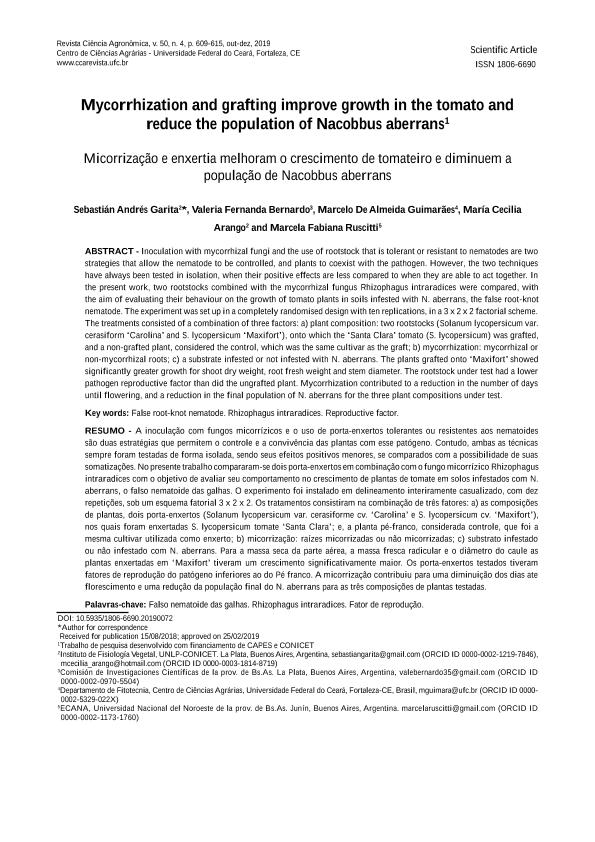Artículo
Inoculation with mycorrhizal fungi and the use of rootstock that is tolerant or resistant to nematodes are two strategies that allow the nematode to be controlled, and plants to coexist with the pathogen. However, the two techniques have always been tested in isolation, when their positive effects are less compared to when they are able to act together. In the present work, two rootstocks combined with the mycorrhizal fungus Rhizophagus intraradices were compared, with the aim of evaluating their behaviour on the growth of tomato plants in soils infested with N. aberrans, the false root-knot nematode. The experiment was set up in a completely randomised design with ten replications, in a 3 x 2 x 2 factorial scheme. The treatments consisted of a combination of three factors: a) plant composition: two rootstocks (Solanum lycopersicum var. cerasiform ‘Carolina’ and S. lycopersicum ‘Maxifort’), onto which the ‘Santa Clara’ tomato (S. lycopersicum) was grafted, and a non-grafted plant, considered the control, which was the same cultivar as the graft; b) mycorrhization: mycorrhizal or non-mycorrhizal roots; c) a substrate infested or not infested with N. aberrans. The plants grafted onto ‘Maxifort’ showed significantly greater growth for shoot dry weight, root fresh weight and stem diameter. The rootstock under test had a lower pathogen reproductive factor than did the ungrafted plant. Mycorrhization contributed to a reduction in the number of days until flowering, and a reduction in the final population of N. aberrans for the three plant compositions under test. A inoculação com fungos micorrízicos e o uso de porta-enxertos tolerantes ou resistentes aos nematoides são duas estratégias que permitem o controle e a convivência das plantas com esse patógeno. Contudo, ambas as técnicas sempre foram testadas de forma isolada, sendo seus efeitos positivos menores, se comparados com a possibilidade de suas somatizações. No presente trabalho compararam-se dois porta-enxertos em combinação com o fungo micorrízico Rhizophagus intraradices com o objetivo de avaliar seu comportamento no crescimento de plantas de tomate em solos infestados com N. aberrans, o falso nematoide das galhas. O experimento foi instalado em delineamento interiramente casualizado, com dez repetições, sob um esquema fatorial 3 x 2 x 2. Os tratamentos consistiram na combinação de três fatores: a) as composições de plantas, dois porta-enxertos (Solanum lycopersicum var. cerasiforme cv. ‘Carolina’ e S. lycopersicum cv. ‘Maxifort’), nos quais foram enxertadas S. lycopersicum tomate ‘Santa Clara’; e, a planta pé-franco, considerada controle, que foi a mesma cultivar utilizada como enxerto; b) micorrização: raízes micorrizadas ou não micorrizadas; c) substrato infestado ou não infestado com N. aberrans. Para a massa seca da parte aérea, a massa fresca radicular e o diâmetro do caule as plantas enxertadas em ‘Maxifort’ tiveram um crescimento significativamente maior. Os porta-enxertos testados tiveram fatores de reprodução do patógeno inferiores ao do Pé franco. A micorrização contribuiu para uma diminuição dos dias ate florescimento e uma redução da população final do N. aberrans para as três composições de plantas testadas.
Mycorrhization and grafting improve growth in the tomato and reduce the population of Nacobbus aberrans
Título:
Micorrização e enxertia melhoram o crescimento de tomateiro e diminuem a população de Nacobbus aberrans
Garita, Sebastián Andrés ; Bernardo, Valeria Fernanda; De Almeida Guimarães, Marcelo; Arango, María Cecilia; Ruscitti, Marcela Fabiana
; Bernardo, Valeria Fernanda; De Almeida Guimarães, Marcelo; Arango, María Cecilia; Ruscitti, Marcela Fabiana
 ; Bernardo, Valeria Fernanda; De Almeida Guimarães, Marcelo; Arango, María Cecilia; Ruscitti, Marcela Fabiana
; Bernardo, Valeria Fernanda; De Almeida Guimarães, Marcelo; Arango, María Cecilia; Ruscitti, Marcela Fabiana
Fecha de publicación:
10/2019
Editorial:
Universidade Federal do Ceará
Revista:
Revista Ciência Agronômica
ISSN:
0045-6888
e-ISSN:
1806-6690
Idioma:
Inglés
Tipo de recurso:
Artículo publicado
Clasificación temática:
Resumen
Palabras clave:
FALSE ROOT-KNOT NEMATODE
,
REPRODUCTIVE FACTOR
,
RHIZOPHAGUS INTRARADICES
Archivos asociados
Licencia
Identificadores
Colecciones
Articulos(INFIVE)
Articulos de INST.DE FISIOLOGIA VEGETAL
Articulos de INST.DE FISIOLOGIA VEGETAL
Citación
Garita, Sebastián Andrés; Bernardo, Valeria Fernanda; De Almeida Guimarães, Marcelo; Arango, María Cecilia; Ruscitti, Marcela Fabiana; Mycorrhization and grafting improve growth in the tomato and reduce the population of Nacobbus aberrans; Universidade Federal do Ceará; Revista Ciência Agronômica; 50; 4; 10-2019; 609-615
Compartir
Altmétricas



